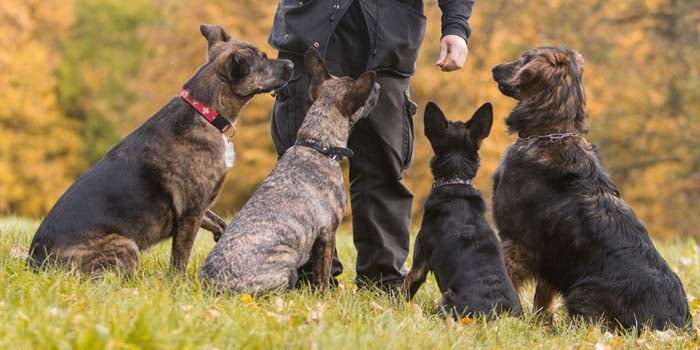Training collars are known by several names — shock collars, remote training collars, electronic dog collars, e-collars — and they are the subject of many opposing opinions about the ethics of using them, how they should be used, and about their usefulness in general. While we feel training collars shouldn’t be the sole approach to behavioral training, they are certainly popular, especially for hunting dogs since training collars can be used at a distance.
These types of collars emit something the dog finds unpleasant — usually an electric shock. But training collars are limited. They can only get rid of an undesirable behavior. They aren't any help in trying to train your pet to do something that you do want him to do, like command training. Shock collars can also be dangerous if misused or if they malfunction.
How to Use Shock Collars in a Humane Fashion
The humane use of a training collar starts before the collar is placed on the dog. Begin training the dog as a puppy to instill desirable behavior and obey commands. Trying to instill a new behavior using a training collar won’t be effective and will do more harm than good. Once your dog knows the desired behavior and can perform it on command, a training collar can be used to reinforce the learned behavior, but it should be used sparingly.
RELATED: Best Alternatives to Dog Shock Collars
Training collars are as humane as the owner wants to make them. If you choose to use one, here’s our advice for using it in the most humane way possible.

Mix positive and negative in your training routine
Use positive reinforcement in conjunction with the training collar. Training your dog shouldn’t be all negative. When your dog does something right, be sure to reward him so that he doesn’t associate you with punishment only. When he obeys your command, give him a dog treat or some extra attention.
RELATED: No More Pain – Best Alternatives to Dog Shock Collars
When your hunting dog does something successful in the field, shower him with praise so he’ll see this activity as a great and entertaining experience instead of one with the threat of a shock held over it. Training then has the dual force of positive and negative reinforcement and is accomplished more quickly, eliminating the need for prolonged use of a training collar.
[optin-monster-shortcode id=”mmevqhqfl46p1is5″]
Risks of training collars
You should be aware of the potential risks of training collars that use electric shock. In addition to a malfunction that can be disastrous (more about that later), shock collars that are used too frequently can cause aversive behavior or anxiety.
A dog should not fear his owner, especially so much that the bond between them is broken. If the two are unable to function as a team, they won’t be able to hunt together, and no amount of training will fix that. Using the collar as a punishment tool may cause the dog to link the outdoors with a negative stimulus, thus causing him to lose all enthusiasm for the sport.
Know when to quit
Know when to stop using a training collar on your dog. If your dog exhibits any type of fearful or anxious behavior, it could be a sign that he is too sensitive for the collar. A
particularly groundbreaking study in the Netherlands showed that frequent use of the collar as a punishment tool (as opposed to a reinforcement tool used only when absolutely necessary) caused aggression, anxiety, and incorrect causal association between pain and you, the owner. The last thing you want to do is harm your dog’s personality and happiness in any way.
Do your research
A training collar should never be a long-term solution. Before you invest in one, know the available alternatives such as a command collar, which emits a tone that only your dog can hear. Frequencies in the upper part of a dog’s hearing range are irritating and uncomfortable. That tone can be associated with different commands and warnings.
Educate yourself
As with everything else, bad things can happen if you use a training collar the wrong way. Ask a veterinarian for advice before using the training collar to make sure that your dog will not be harmed. Invest some time in learning the best way to use it, and observe your dog carefully for his reaction. The pain from the electric shock makes some dogs aggressive, even toward you.

Make it quick and use it consistently
Make the shock last the least amount of time. Even the briefest burst is enough to get your dog’s attention. If the stimulation level is adjustable, pick the lowest level that works.
RELATED: How Owners Lose Their Dogs' Trust
Use the collar consistently. Don’t shock your dog at random. Pick a behavior that you want to correct — be it continuing to run after you’ve instructed him to stop or some other misbehavior — and use the collar only for that. Inconsistent use of the collar will drag out the training past a reasonable point, which could have negative consequences.
Use a reputable and trustworthy brand
In addition to using the collar properly, make sure you choose a reputable brand that is not apt to malfunction. A malfunctioning dog collar can continue to shock your dog after you’ve stopped, perhaps to the extent that it causes nerve damage. It can also cause burns so severe that they create deep lacerations in your dog’s neck and cause serious damage, not just physically but also emotionally.
Recommended dog products
Some top-rated brands that you may want to try are Dogwidgets, SportDOG, and PetSafe.
Dogwidgets offers a collar that emits a strong vibration rather than an actual electric shock. While still unpleasant, it doesn’t cause the discomfort of an electric shock.
It’s important to use the collar correctly, and collars from SportDOG and PetSafe are recommended because of their simplicity and ease of use.
Although there are conflicting opinions about training collars as we said above, if you’re informed, careful, and humane, you could be successful in eliminating undesirable behaviors.













